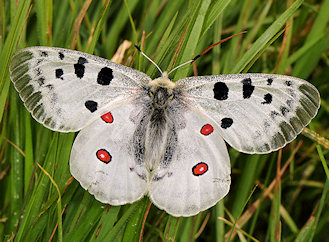Parnassius apollo

Photo Credits: Paolo Mazzei – www.leps.it
Distribution: It is found on mountains in Europe usually above 700 metres up to 3,000 m, preferring flowery meadows and mountain pastures. This species is of interest to entomologists due to the variety of subspecies, often only restricted to a specific valley in the Alps.
Description:Wingspan 50-80 mm. The Apollo butterfly is a beautiful white butterfly, decorated with large black “eye” spots on the forewings and red eye-spots on the hindwings.These striking red eye-spots can vary in size and form depending on the location of the Apollo butterfly, and the bright red colour often fades in the sun, causing the eye-spots of older individuals to appear more orange.The wings are shiny, with slightly transparent edges,and some individuals are darker (melanistic); a general phenomenon common in many butterflies. The caterpillars of this species are velvety black with orange-red spots along the sides.
Biology: Adult Apollo butterflies are seen on the wing in mid-summer,feeding on nectar produced by flowers.The females lay eggs, which over-winter and hatch in spring the following year.The resulting caterpillars feed on stonecrop (Sedum species) and houseleek (Sempervivum species). When the caterpillar is fully-grown it will pupate on the ground, forming a loose cocoon from which the adult butterfly emerges following metamorphosis.

